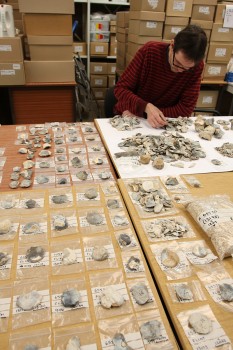
It is widely accepted that not all the records and materials collected or created during the course of an archaeological project require preservation in perpetuity. These records and materials constitute the working project archive, which will be subject to selection, in order to establish what will be retained for long-term curation.
The aim of selection is to ensure that all the elements retained from the working project archive for inclusion in the archaeological archive are appropriate to establish the significance of the project and support future research, outreach, engagement, display and learning activities. Selection should be focused on choosing what is to be retained to support these future needs, rather than deciding what can be dispersed.
A selection strategy details the project-specific selection process, agreed by all stakeholders, that will be applied to a working project archive prior to its transfer into curatorial care as the archaeological archive.
The benefits of a selection strategy
The implementation of a project-specific selection strategy will
- ensure that the archaeological archive is fit for purpose and contains well organised records and materials that have the potential for re-use, further research, and/or other curatorial use that will add to our archaeological understanding
- facilitate better knowledge of the archaeological archive’s contents
- establish the relevance of the archaeological archive, and therefore increase the opportunities for promotion of, and engagement with, the archaeological archive
- better enable the full and equitable consideration of the importance and potential of all materials
- enable a better understanding of, and preparation for, the preservation requirements of the working project archive prior to the transfer of the archaeological archive to a repository
- help ensure that all relevant procedures and guidance have been considered and followed at all stages of a project
- promote better collaboration between contracting units, collecting institutions, specialists, researchers, planning archaeologists and other stakeholders
- improve the active management of the working project archive, including onsite collection, and the dispersal of de-selected material
- support the adequate allocation of funds and staffing from the outset of a project
- improve the efficient use of available storage space and resources


Download Quick-links
Access the template files associated with the toolkit below. See the Downloads page to view all toolkit files.
All records and materials recovered during an archaeological project and identified for long-term preservation, including artefacts, ecofacts and other environmental remains, waste products, scientific samples and also written and visual documentation in paper, film and digital form (Perrin et al 2014, 20).
Any programme of work that involves the collection and/or production of information about an archaeological site, assemblage or object in any environment, including in the field, under water, at a desk or in a laboratory. Examples of an archaeological project include: intrusive projects such as excavation, field evaluation, watching brief, surface recovery and the destructive analysis of objects; non-intrusive projects such as landscape or building survey, aerial survey, remote sensing, off-site research such as desk-based assessment and the recording of objects or object assemblages (Perrin et al 2014, 20).
One product of an archaeological project will be an archaeological archive.
Receives an Archaeological Archive from the Depositor for long-term curatorial care.
The parts of the working project archive not selected for inclusion in the archaeological archive.
The process of dealing with De-selected Material, including incorporation into handling boxes, donation to reference collections, or destruction. All Stakeholders should be included in determining methods of dispersal.
All materials recovered during an Archaeological Project including:
- Artefacts, such as pottery, tile, worked stone, glass, metalwork, worked bone, leather and textile;
- Biological remains, such as animal bone and botanical material;
- Waste products, such as industrial residue, hammerscale and off-cuts;
- Material extracted during analysis, such as thin-sections, microfossil slides, dendrochronological specimens.
The process of applying a selection strategy to a working project archive to determine which archive components, including documents, digital files and material objects, should be included in the archaeological archive. The aim of selection is to ensure that the archaeological archive contains everything required to establish the significance of the project and support future research, outreach, engagement, display and learning activities.
The methodology detailing the project-specific selection process, agreed by all stakeholders, that will be applied to the working project archive in order to create the archaeological archive.
The data management plan is a separate document to the selection strategy but should be developed in conjunction with it. Both documents should be included in pre-project documentation (eg project design and/or WSI).
An individual who is competent in, and specialises in, collecting, recording, analysing, interpreting and/or reporting on specific materials, objects or scientific data. A Specialist will have developed expertise through the extensive study in their particular field, working to accepted standards of practice and ethics, and reporting in reputable peer reviewed sources. They should also be accredited in line with any recognition schemes in place for their field of expertise.
The individuals or institutions with a stake in the formulation and implementation of the Selection Strategy. For example; the contracting unit or individual/group (e.g. universities and community groups) undertaking the project, the Collecting Institution accepting the Archaeological Archive, representatives of the developers or landowners, the Project Executive and Specialists working on the project.
The records and materials gathered during an archaeological project and retained for analysis prior to selection for the archaeological archive.


